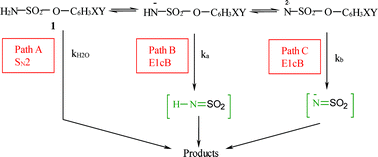Mechanisms of hydrolysis of phenyl- and benzyl 4-nitrophenyl-sulfamate esters†
Abstract
The kinetics of ![[double bond, length as m-dash]](https://www.rsc.org/images/entities/char_e001.gif) SO2] as an intermediate. In more alkaline solution further ionization of the conjugate base of the
SO2] as an intermediate. In more alkaline solution further ionization of the conjugate base of the ![[double bond, length as m-dash]](https://www.rsc.org/images/entities/char_e001.gif) SO2]; in a final step, rapid attack of
SO2]; in a final step, rapid attack of

* Corresponding authors
a
School of Chemistry, National University of Ireland, Galway, Ireland
E-mail:
william.spillane@nuigalway.ie
Fax: +353 91 525700
Tel: +353 91 492475
b
Dipartimento di Chimica e Chimica Industriale, Università di Genova, Italy
E-mail:
sergio.thea@chimica.unige.it
c
Consiglio Nazionale delle Ricerche - Istituto di Metodologie Chimiche, Roma, Italy
E-mail:
giocev@chimica.unige.it
The kinetics of ![[double bond, length as m-dash]](https://www.rsc.org/images/entities/char_e001.gif) SO2] as an intermediate. In more alkaline solution further ionization of the conjugate base of the
SO2] as an intermediate. In more alkaline solution further ionization of the conjugate base of the ![[double bond, length as m-dash]](https://www.rsc.org/images/entities/char_e001.gif) SO2]; in a final step, rapid attack of
SO2]; in a final step, rapid attack of

 Please wait while we load your content...
Something went wrong. Try again?
Please wait while we load your content...
Something went wrong. Try again?
W. J. Spillane, S. Thea, G. Cevasco, M. J. Hynes, C. J. A. McCaw and N. P. Maguire, Org. Biomol. Chem., 2011, 9, 523 DOI: 10.1039/C0OB00362J
To request permission to reproduce material from this article, please go to the Copyright Clearance Center request page.
If you are an author contributing to an RSC publication, you do not need to request permission provided correct acknowledgement is given.
If you are the author of this article, you do not need to request permission to reproduce figures and diagrams provided correct acknowledgement is given. If you want to reproduce the whole article in a third-party publication (excluding your thesis/dissertation for which permission is not required) please go to the Copyright Clearance Center request page.
Read more about how to correctly acknowledge RSC content.
 Fetching data from CrossRef.
Fetching data from CrossRef.
This may take some time to load.
Loading related content
